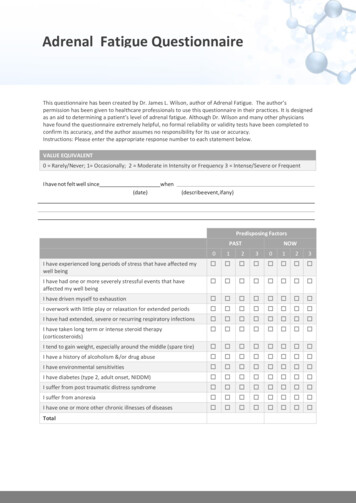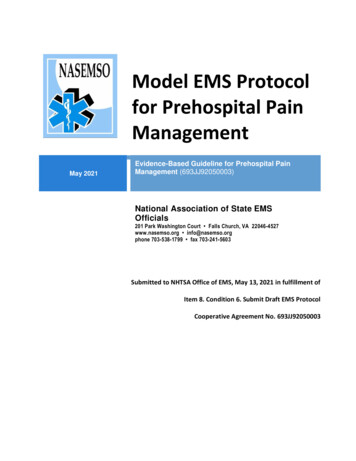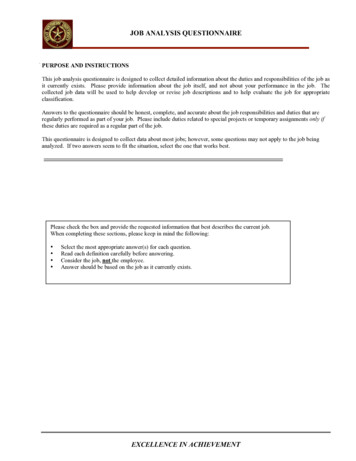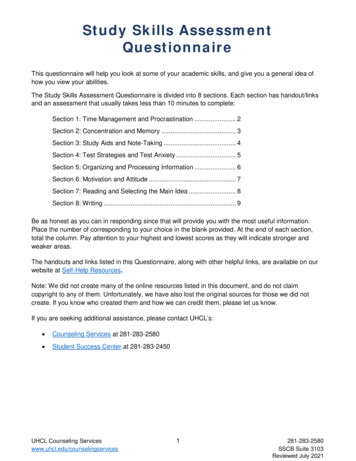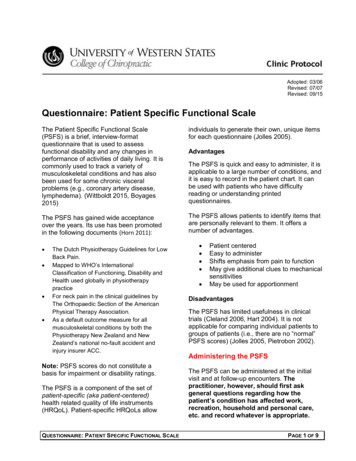
Transcription
Adopted: 03/06Revised: 07/07Revised: 09/15Questionnaire: Patient Specific Functional ScaleThe Patient Specific Functional Scale(PSFS) is a brief, interview-formatquestionnaire that is used to assessfunctional disability and any changes inperformance of activities of daily living. It iscommonly used to track a variety ofmusculoskeletal conditions and has alsobeen used for some chronic visceralproblems (e.g., coronary artery disease,lymphedema). (Wittboldt 2015, Boyages2015)individuals to generate their own, unique itemsfor each questionnaire (Jolles 2005).The PSFS has gained wide acceptanceover the years. Its use has been promotedin the following documents (Horn 2011):The PSFS allows patients to identify items thatare personally relevant to them. It offers anumber of advantages. The Dutch Physiotherapy Guidelines for LowBack Pain.Mapped to WHO’s InternationalClassification of Functioning, Disability andHealth used globally in physiotherapypracticeFor neck pain in the clinical guidelines byThe Orthopaedic Section of the AmericanPhysical Therapy Association.As a default outcome measure for allmusculoskeletal conditions by both thePhysiotherapy New Zealand and NewZealand’s national no-fault accident andinjury insurer ACC.Note: PSFS scores do not constitute abasis for impairment or disability ratings.The PSFS is a component of the set ofpatient-specific (aka patient-centered)health related quality of life instruments(HRQoL). Patient-specific HRQoLs allowQUESTIONNAIRE: PATIENT SPECIFIC FUNCTIONAL SCALEAdvantagesThe PSFS is quick and easy to administer, it isapplicable to a large number of conditions, andit is easy to record in the patient chart. It canbe used with patients who have difficultyreading or understanding printedquestionnaires. Patient centeredEasy to administerShifts emphasis from pain to functionMay give additional clues to mechanicalsensitivitiesMay be used for apportionmentDisadvantagesThe PSFS has limited usefulness in clinicaltrials (Cleland 2006, Hart 2004). It is notapplicable for comparing individual patients togroups of patients (i.e., there are no “normal”PSFS scores) (Jolles 2005, Pietrobon 2002).Administering the PSFSThe PSFS can be administered at the initialvisit and at follow-up encounters. Thepractitioner, however, should first askgeneral questions regarding how thepatient’s condition has affected work,recreation, household and personal care,etc. and record whatever is appropriate.PAGE 1 OF 9
Then specific activities can be chosen toestablish a measurable baseline and tracktreatment response.Standardization in the use of the PSFS willhelp to insure comparable scores from visitto visit and from examiner to examiner. Inorder to achieve reliable and accurateresults with the PSFS, it must be performedin the same manner each time and by eachexaminer.The practitioner recites or reads the scriptfrom a questionnaire form. The script shouldbe followed precisely and consistently.Patients are asked to identify threeimportant activities that they are havingdifficulty with as a result of their healthproblem. (Note: the reported accuracy andresponsiveness of the PSFS is based onaveraging 3 separate activities).It may be necessary to remind patients tofocus on their ability to perform activitiesrather than the pain they have whenperforming them.For each of three self-generated activities,the patient rates performance difficulty on a0 to 10 scale, where 0 is complete inabilityto perform the activity and 10 is 100%functional. This can be done by using avisual analogue scale (see appendix) andasking the patient to select one number onthe scale for each activity.condition because the score cannot go anylower. (Jolles 2005). To avoid this shortcomingthe following question can be asked at followup visits (Beurskens 1999):“Are there any [up to two] other activities thatyou are having difficulty with since your lastvisit?”Clinic TipSome patients will only be able to come up with oneor two activities. Some will not be able to relate tothe question at all. After a few attempts, do notspend an inordinate amount of time forcing thesepatients into answering.Revisit the baseline activities at follow up visits(rather than including new ones). The patientcan be reminded of prior scores and thenasked to re-grade the same activities.Script Subsequent Visits“When I assessed you on (state previousassessment date), you told me that you difficultywith (read 1, 2, 3, 4, 5 from list).“Today, do you still have difficulty with 1 (havepatient score each activity); 2 (have patient scoreeach activity) .” and so on.Scoring and Charting the PSFS Higher scores indicate better function. There is no total score; each activity isScript (first measure) “I am going to ask you to identify up to threeimportant activities that you are unable to do orare having difficulty with as a result of yourproblem. Today, are there any activities that you areunable to do or you are having difficulty withbecause of yourproblem?”(Show the scale to the patient and have thepatient rate each activity.)Note: If baseline scores all receive a scoreof zero, then the PSFS score will not beable to detect any worsening of theQUESTIONNAIRE: PATIENT SPECIFIC FUNCTIONAL SCALEboth averaged and scored as aseparate item.The average score is the moreaccurate measurement for trackingresponsiveness.In a SOAP format, the average andindividual scores would be entered inthe S portion.Minimally Clinically Important Difference(MCID)To detect a clinically significant change, ingeneral, there must be a difference of at least3 points for a single activity or 2 points for theaverage of all of the activities (sum of activityscores divided by the number of activities).(Cleland 2006, Westaway 1998). SomePAGE 2 OF 9
researchers have come up with slightvariations depending on the condition.strengthening hip extensors may beappropriate.Overcoming Illness BehaviorsThe PSFS can be used to focus therapeuticattention on improving activity tolerance. ThePSFS is not concerned with pain. A clinicianmay choose to use the PSFS as part of alarger strategy to deemphasize the importanceof painful somatic sensations. Thus, the PSFScan be used as a tool to help to diminishhypervigilance for pain and somaticpreoccupation.ApportionmentClinical Decision MakingThe PSFS is a sensitive measure ofclinically significant change in a patient’scondition. Therefore, it is useful indetermining if a patient is getting better orworse or staying the same. Improvement inthe PSFS score suggests that a therapeuticregimen is useful; stasis or regressionsuggests a need for a change in therapy. Atrend of stasis, despite changes in therapy,may suggest that the patient is medicallystationary* or that referral for a secondopinion is warranted.PSFS scores could also be used to help insetting an apportionment when a patient hastwo injuries and the practitioner is asked toapportion the effect of each for insurancepurposes. See the following example:Injury 1The PSFS average of 3 affected activities was4.6 at the last visit prior to injury 2. This meansthat the patient could engage in the targetedactivities at 46% of pre-injury status.The amount of lost function is the inverse—54%.Selecting Physical Performance TestsInjury 2 (the current injury being treated)Identification of specific activity intolerancescan be used to direct physical examprocedures. For example, if a patientidentifies driving a car as difficult, cervicalactive range of motion or Jull’s test may beappropriate performance tests.The average of the 3 activities is now only 2.2(or 22%) representing a 78% loss of function.Directing Physical RehabilitationIdentification of specific activity intolerancescan be used to direct the course of atherapeutic exercise program. For example,if a patient identifies that an activity whichrequires squatting or lifting is difficult, thentesting squat and rise endurance and*The term medically stationary should be use onlywith great care. It denotes that a patient is not likelyto improve with continued care. Most third partypayers will not continue to reimburse.QUESTIONNAIRE: PATIENT SPECIFIC FUNCTIONAL SCALETo determine how much of the patient’s currentproblem is attributable to the first injury, dividethe prior loss of function (.54) by the currentloss of function (.78).54/.78 69%.69% of the patient’s current status isattributable to the first injury; the remaining31% is due to the second injury.If there were two different 3rd party payers, thiscalculation could be used to help determinehow the costs would be divided for continuingcare.PAGE 3 OF 9
Validity†, Reliability‡, andResponsiveness§ of the PSFSThe validity, reliability and/orresponsiveness of the PSFS have beentested in patients with neck pain, cervicalradiculopathy, chronic whiplash, back painand knee pain (Beurskens 1999, Chatman1997, Cleland 2006, Pengel 2004, Steward2007, Stratford 1995, Westaway 1998).(The table on the next page lists selectedfindings from these studies.)A 2011 systematic review of 13 studies alsoreported the PSFS to be valid, reliable, andresponsive in populations with knee dysfunctioncervical radiculopathyacute low back painmechanical low back painneck dysfunction.The PSFS was also found to be reliable andresponsive in populations with chronic lowback pain.(Horn 2012).The test is responsive in individuals withcarpal tunnel syndrome, finger contracture,subacute low back pain, and chronicwhiplash. (Horn 2012)†Test Validity is crucial for establishing the clinicalusefulness of an assessment instrument. Validity refers tohow accurately an assessment procedure measures theclinical state of a patient as compared to a gold standard. Inthe absence of a gold standard, construct validity is used asa suitable surrogate. Construct validity is established throughcomparison with other measures that are theoreticallyrelated to the clinical condition being evaluated. Functionalstatus questionnaires are tested for construct validity bycomparison with other instruments and with other clinicalfeatures that would be expected to correlate with physicalfunction.‡Reliability refers to the repeatability of a test and itindicates precision and consistency. A reliable test isrepeatable, precise and consistent.§Responsiveness refers to a test's ability to measurechange over time. Responsiveness is defined as the abilityof an instrument to detect clinically important changes. Theresponsiveness of an instrument can be used to describe itsability to detect improvement or nonimprovement ascompared to an external criterion.QUESTIONNAIRE: PATIENT SPECIFIC FUNCTIONAL SCALEPAGE 4 OF 9
ConditionNeck PainPsychometric PropertyReliabilityConstruct ValiditySensitivity to Change (i.e., responsiveness)R .92r .73-.83: correlationof PSFS with NeckDisability Index.r .79-.83: correlation of PSFS change with Neck DisabilityIndex change.r .52-.64: correlationof PSFS withprognosis rating.r .46-.53: correlation of PSFS change with prognosis rating.r .82: correlation ofPSFS with GlobalRating of Change.AUC .99(AUC – Area Under the Curve. AUC refers to the receiveroperating characteristic curve, a measure of responsiveness.An AUC of 0.50 indicates no accuracy beyond chance. AnAUC of 1.0 indicates perfect accuracy.)(Westaway 1998)CervicalRadiculopathy(Cleland 2006)r .80: correlation ofPSFS with NumericPain Rating ScaleChronicWhiplashBased on effect size and internal responsiveness analysis, thePSFS was more sensitive to change than a visual analoguescale for pain, the NDI, SF-36 (physical summary measure),the Copenhagen Scale, or the Functional Rating Index(disability measures).(Steward 2007)Back PainEffect Size (ES) mean change / standard deviation ofchange. The ES of the 3 main complaints in the improvedgroup were respectively: 2.30, 2.53 and 2.26. In the improvedgroup some patients showed more improvement on the maincomplaints than on the other outcome measures. The maincomplaints were the most sensitive to change.(Beurskens1999)Back PainThe PSFS was the most responsive of three measures. Effectsize measures: PSFS 1.6Numerical pain scale 1.3Roland Morris Questionnaire 0.8.(Pengel 2004)Knee PainR .84r .78(Chatman 1997)R – intraclass correlation coefficient [type 2,1]r - Pearson's rFor a detailed analysis of the methodological challenges in the evaluation of health statusmeasures see: Stratford PW, Riddle DL. Assessing sensitivity to change: Choosing the appropriatechange coefficient. Health Qual Life Outcomes 2005;3:23. (The electronic version of this article can befound online at: http://www.hqlo.com/content/3/1/23).Copyright 2006 & 2007 Western States Chiropractic College and 2015 UWSQUESTIONNAIRE: PATIENT SPECIFIC FUNCTIONAL SCALEPAGE 5 OF 9
Primary author (2006): Owen T. Lynch, DCRevised (2015): Ron LeFebvre, DC &Owen Lynch, DCRevised by CSPE Working Group (2015)– Amanda Armington, DC– Lorraine Ginter, DC– Shawn Hatch, DC– Owen T. Lynch, DC– Ryan Ondick, DC– James Strange, DC– Michael Tarnasky, DCReviewed by CSPE Committee (3/06)- Shireesh Bhalerao, DC- Daniel DeLapp, DC, DABCO, LAc, ND- Elizabeth Dunlop, DC- Lorraine Ginter, DC- Sean Herrin, DC- Ronald LeFebvre, DC- Owen T. Lynch, DC- Karen E. Petzing, DC- Ravid Raphael, DC, DABCO- Anita Roberts, DC- Steven Taliaferro, DC- Also reviewed by: Mitch Haas, DCandWill Evans, DC, PhDStan Ewald, DC, MPH, M.Ed.Joseph Pfeifer, DCReviewed by CSPE Committee (7/07)– Shireesh Bhalerao, DC– Daniel DeLapp, DC, DABCO, LAc, ND– Lorraine Ginter, DC– Stover Harger, DC– Sean Herrin, DC– Ronald LeFebvre, DC– Owen T. Lynch, DC– Karen E. Petzing, DC– Ravid Raphael, DC, DABCO– Anita Roberts, DC– Steven Taliaferro, DCReferencesBarten JA, Pisters MF, et al. Measurement properties of patient-specific instruments measuring physical function. Journalof Clinical Epidemiology, 65 (2012) 590-601Beurskens AJ, de Vet HC, Köke AJ, et al. A patient-specific approach for measuring functional status in low back pain. JManip Physiol Ther 1999;22(3):144-8.Boyages J1, Kastanias K, Koelmeyer LA, Winch CJ, Lam TC, Sherman KA, Munnoch DA, Brorson H, Ngo QD, HeydonWhite A, Magnussen JS, Mackie H. Liposuction for Advanced Lymphedema: A Multidisciplinary Approach forComplete Reduction of Arm and Leg Swelling. Ann Surg Oncol. 2015 Jun 30.Chatman AB, Hyams SP, Neel JM, et al. The patient-specific functional scale: Measurement properties in patients withknee dysfunction. Phys Ther 1997;77(8):820-9.Cleland JA, Fritz JM, Whitman JM, Palmer JA. The reliability and construct validity of the neck disability index and patientspecific functional scale in patients with cervical radiculopathy. Spine 2006;31(5): 598-602.Hart DL, Werneke MW. Letters. Spine 2004;29(21):2475-6.Horn KK, Jennings S et al. The patient-specific functional scale: psychometrics, clinimetrics, and application as a clinicaloutcome measure. Orthop Sports Phys Ther 2012;42(1):30-42,Liebenson C. Rehabilitation of the Spine: a Practitioner’s Manual, 2Wilkins; 2007.ndedition. Philadelphia, PA: Lippincott Williams &Jolles BM, Buchbinder R, Beaton DE. A study compared nine patient-specific indices for musculoskeletal disorders. JClin Epidemiol 2005;58(8):791-801.Pengel LHM, Refshauge KM, Maher CG. Responsiveness of pain, disability, and physical impairment outcomes inpatients with low back pain. Spine 2004;29(8):879-83.Pietrobon R, Coeytaux RR, Carey TS, Richardson WJ, DeVellis RF. Standard scales for measurement of functionaloutcome for cervical pain or dysfunction: A systematic review. Spine 2002;27(5):515-22.Stewart M, Maher CG, Refshauge KM, Bogduk N, Nicholas M. Responsiveness of pain and disability measures forchronic whiplash. Spine 2007;32:580-5.QUESTIONNAIRE: PATIENT SPECIFIC FUNCTIONAL SCALEPAGE 6 OF 9
Stratford PW, Gill C, Westaway MD, Binkley JM. Assessing disability and change on individual patients: A report of apatient specific measure. Physiother Can 1995;47:258-63.Westaway MD, Stratford PW, Binkley JM. The patient-specific functional scale: Validation of its use in persons with neckdysfunction. J Orthop Sports Phys Ther 1998;27(5):331-8.Wittboldt S, Cider Å, Bäck M. Reliability of two questionnaires on physical function in patients with stable coronary arterydisease. Eur J Cardiovasc Nurs. 2015 Jul 8.QUESTIONNAIRE: PATIENT SPECIFIC FUNCTIONAL SCALEPAGE 7 OF 9
APPENDIX: Patient Specific Functional Scale (PSFS)Patient DateClinical Supervisor InternInitial AssessmentComplete when interviewing patient about effects on ADLs. Follow this script (avoid using the wordpain):“I am going to ask you to identify three important activities that you are unable to do or are havingdifficulty with as a result of your problem. Today, are there anyactivities that you are unable to do or you are having difficulty with because of yourproblem?” (Show the scale to the patient and have the patientrate each activity.)Note: If the activities are at 0 or 1 ask the following question: “Are there any [up to two] other activitiesthat you are having difficulty with since your last visit?” Remember that on the PSFS scale, zero is the worst score (the patient cannot perform theactivity) and 10 is the best score (the patient is able to perform the activity at the same level asbefore the injury or problem). This is the opposite of the VAS scale of pain. It may be helpful toclarify this point before showing the scale to the patient.Follow–up assessments on subsequent office visitsFollow this script. Use the anchor terms exactly as written.“When I assessed you on [state previous assessment date], you told me that you had difficulty with[read all activities from the list at a time]. Today, do you still have difficulty with [read and have thepatient score each item in the list]?PATIENT–SPECIFIC ACTIVITY SCORING SCHEME (point to one number)012345Unable toperform activityQUESTIONNAIRE: PATIENT SPECIFIC FUNCTIONAL SCALE678910Able to perform activity atthe same level as beforethe injury or problemPAGE 8 OF 9
PSFS Scores for Problem coreScore12345AverageNote: To detect a clinically significant change, there must be a difference of at least 3 points for a single activity or 2 points forthe average of all of the activities (sum of activity scores divided by the number of activities).PSFS Scores for Problem coreScore12345AverageNote: To detect a clinically significant change, there must be a difference of at least 3 points for a single activity or 2 points forthe average of all of the activities (sum of activity scores divided by the number of activities).QUESTIONNAIRE: PATIENT SPECIFIC FUNCTIONAL SCALEPAGE 9 OF 9
Questionnaire: Patient Specific Functional Scale The Patient Specific Functional Scale (PSFS) is a brief, interview-format questionnaire that is used to assess functional disability and any changes in performance of activities of daily living. It is commonly used to t

